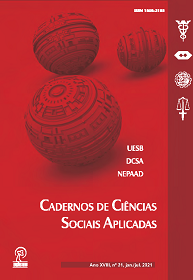Productive structure of the Bahian semiarid: an input-output analysis
DOI:
https://doi.org/10.22481/ccsa.v18i31.7979Keywords:
Bahian semiarid. Development. Input-output matrix. Productive structure.Abstract
The objective of this study is to analyze the productive structure of the Bahian semiarid in 2015 and to contribute to the development of public policies that foster its development. For this purpose, the input-product tooling is used to build the input-product matrix of the Bahian semiarid, based on the Bahia 2015 matrix. An exploratory study of the economic activity sectors of the region is carried out, using input indicators -product as Rasmussen-Hirschman intersectoral link indices, key sector, field of influence and economic multipliers of production, employment and income. The analysis showed that seven sectors are of great importance for the region - others in the extractive industry; food, drinks and tobacco; textiles, clothing and leather articles; various chemical products; rubber and plastic industry; metallurgy and steel; electricity, gas, water, sewage and urban cleaning - acting as demand for inputs and product offerers. Economic multipliers have shown that the alcohol and biofuels sector is the most prominent in production. Public administration, health and public education and social security have the greatest potential to generate formal jobs in the economy. Regarding income generation, the agricultural sector has a weight in the region, with emphasis on the cultivation of cereals and other temporary crops. Thus, when evaluating the productive structure of the Bahian semiarid region, it is expected to contribute with the agents involved in decision-making for the development of policies aimed at their social and economic development.
Downloads
References
BACHARACH, M. Biproportional matrices and input-output change. Cambridge: Cambridge University Press, 1970.
BAHIA. Secretaria de Desenvolvimento Econômico (SDE). Energia Eólica. 2018.
______. Superintendência de Estudos Econômicos e Estatísticos (SEI). PIB Municipal. 2016.
BRASIL. Superintendência do Desenvolvimento do Nordeste (SUDENE). Delimitação do semiárido. 2018.
CABRAL, J. A.; CABRAL, M. V. F.; OLIVEIRA, D. R. Análise do conteúdo tecnológico das exportações brasileiras sob a lógica estruturalista-kaldoriana. Nova Economia, v.27, n. 2, p. 157-184, 2017.
DIETZENBACHER, E.; VAN DER LINDEN, J. A.; STEENGE, A. E. The regional extraction method: EC input-output comparisons. Economic Systems Research, v. 5, n. 2, 1993.
GONÇALVES, M. F.; NEVES, M. C. R.; BRAGA, M. J. Análise da economia baiana em 2011 à luz da matriz insumo-produto. Nexos econômicos. Salvador, v. 8, n. 2, 2014.
GUILHOTO, J. J. M. Input – Output Analysis: Theory and Foundations. FEA-USP. 2011.
GUILHOTO, J. J. M.; AZZONI, C. R.; ICHIHARA, S. M.; KADOTA, D. K.; HADDAD, E. A. Matriz de Insumo-Produto do Nordeste e Estados: Metodologia e Resultados. Fortaleza: Banco do Nordeste do Brasil, 2010.
HIRSCHMAN, A.O. The Strategy of Economic Development. Yale University Press. 1958.
LEITE, A.P.V. Uma metodologia para construção de matrizes regionais compatíveis - o RAS modificado agregado: uma aplicação para as grandes regiões do Brasil em 2006. Dissertação, Universidade Federal da Bahia, Salvador, 2009.
LEITE, A. P. V.; PEREIRA, R. M. Matriz insumo-produto da economia baiana: uma análise estrutural e subsídios às políticas de planejamento. Revista Desenbahia, v. 7, n. 13, 2010.
LOPES, P. R. C. Alternativas de manejo de solo e água para o Semiárido brasileiro. 2003. Disponível em: www.comciencia.br/reportagens. Acesso em 03 de agosto de 2018.
MEDEIROS, S. de S. et al. Sinopse do Censo Demográfico para o Semiárido Brasileiro. Campina Grande: INSA, 2012.103p.
MILLER, R.E.; P.D. BLAIR. Input-Output Analysis: Foundations and Extensions. 2 ed. Cambrige: Cambridge University Press. 2009.
MYRDAL, G. Economic theory and under-developed regions. LTD:London, 1957.
NASCIMENTO, H. M. Semiárido Brasileiro e Baiano: dimensão territorial e estratégia de desenvolvimento. 48º Congresso Sober, 2010.
PEREIRA, R. M. Aspectos econômicos dos modelos de cobrança da água pelo lançamento de efluentes: a bacia hidrográfica do rio Paraíba do Sul. UFBA, Salvador, 2007.
PEROBELLI, F. S.; VALE, V. A.; PIRES, M. M. SANTOS, J. P. C.; ARAÚJO JÚNIOR, I. F. Estimativa da matriz de insumo-produto da Bahia (2009): características sistêmicas da estrutura produtiva do estado. Revista Econômica do Nordeste, Fortaleza, v. 46, n. 4, 2015.
PERROUX, F. A Economia do Século XX. Lisboa: Livraria Morais Editora, 1967. 755 p.
______. Nota Sobre o Conceito de “Polo de Crescimento”. In: PERROUX, F; FRIEDMANN, J; TINBERGEN, J. A Planificação e os Polos de Desenvolvimento. Porto: Edição Rés Limitada, p. 5-26, 1975. 82 p.
PRADO, E. F. S. Estrutura tecnológica e desenvolvimento regional. IPE/USP, 1981. 230 p.
RASMUSSEN, P. Studies in Intersectoral Relations. Amsterdam: North Holland. 1956.
RIBEIRO, C. S; OLIVEIRA, G. G. The water question in the bahian semi-arid and the social technologies for the use of rainwater. Revista del Cesla, n. 23, 2019.
RIBEIRO, L. C. S.; ROCHA, G. B. Interdependência produtiva e estratégias de desenvolvimento para o estado da Bahia. Economia Ensaios, v. 27, n. 2, p. 67-83, 2013.
SILVA, R. M. A. Entre o combate à seca e a convivência com o Semiárido: transições paradigmáticas e sustentabilidade do desenvolvimento. 2006. 298p. Tese de Doutorado – Centro de Desenvolvimento Sustentado, Universidade de Brasília.
SILVEIRA, A. H. P. Uma variante do método biproporcional para a estimativa de matrizes de relações intersetoriais na ausência de dados sobre produção intermediária. In: Congresso Nacional de Economia, Anais... Belo Horizonte: ANPEC, 1993.
SONIS, M.; HEWINGS, G.J.D. Error and Sensitivity Input-Output Analysis: a New Approach. In: R.E. Miller, K.R. Polenske e A.Z. Rose (eds.) Frontiers of Input-Output Analysis. New York, Oxford University Press. 1989.
_________. Fields of Influence in Input-Output Systems. University of Illinois, Regional Economics Applications Laboratory, 1994.
STONE, R. Input-output and demographie accouting: a tool for education planning. Minerva, v. 4, n. 3, p. 365-380, 1962.
Downloads
Published
Issue
Section
License
Copyright (c) 2021 Cadernos de Ciências Sociais Aplicadas

This work is licensed under a Creative Commons Attribution-NonCommercial 4.0 International License.












